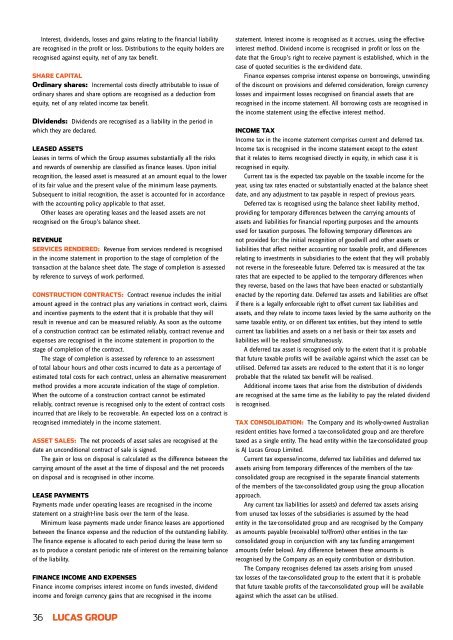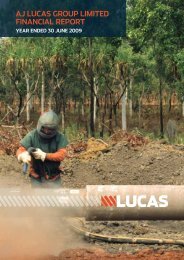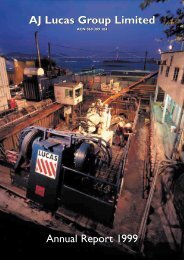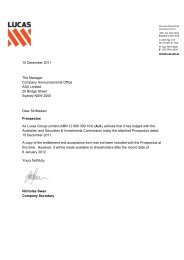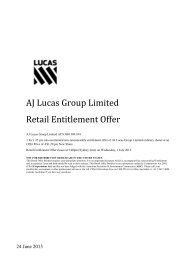AJ Lucas Group annual report 2007-08
AJ Lucas Group annual report 2007-08
AJ Lucas Group annual report 2007-08
Create successful ePaper yourself
Turn your PDF publications into a flip-book with our unique Google optimized e-Paper software.
Interest, dividends, losses and gains relating to the financial liability<br />
are recognised in the profit or loss. Distributions to the equity holders are<br />
recognised against equity, net of any tax benefit.<br />
Share capital<br />
Ordinary shares: Incremental costs directly attributable to issue of<br />
ordinary shares and share options are recognised as a deduction from<br />
equity, net of any related income tax benefit.<br />
Dividends: Dividends are recognised as a liability in the period in<br />
which they are declared.<br />
Leased assets<br />
Leases in terms of which the <strong>Group</strong> assumes substantially all the risks<br />
and rewards of ownership are classified as finance leases. Upon initial<br />
recognition, the leased asset is measured at an amount equal to the lower<br />
of its fair value and the present value of the minimum lease payments.<br />
Subsequent to initial recognition, the asset is accounted for in accordance<br />
with the accounting policy applicable to that asset.<br />
Other leases are operating leases and the leased assets are not<br />
recognised on the <strong>Group</strong>’s balance sheet.<br />
Revenue<br />
Services rendered: Revenue from services rendered is recognised<br />
in the income statement in proportion to the stage of completion of the<br />
transaction at the balance sheet date. The stage of completion is assessed<br />
by reference to surveys of work performed.<br />
Construction contracts: Contract revenue includes the initial<br />
amount agreed in the contract plus any variations in contract work, claims<br />
and incentive payments to the extent that it is probable that they will<br />
result in revenue and can be measured reliably. As soon as the outcome<br />
of a construction contract can be estimated reliably, contract revenue and<br />
expenses are recognised in the income statement in proportion to the<br />
stage of completion of the contract.<br />
The stage of completion is assessed by reference to an assessment<br />
of total labour hours and other costs incurred to date as a percentage of<br />
estimated total costs for each contract, unless an alternative measurement<br />
method provides a more accurate indication of the stage of completion.<br />
When the outcome of a construction contract cannot be estimated<br />
reliably, contract revenue is recognised only to the extent of contract costs<br />
incurred that are likely to be recoverable. An expected loss on a contract is<br />
recognised immediately in the income statement.<br />
Asset sales: The net proceeds of asset sales are recognised at the<br />
date an unconditional contract of sale is signed.<br />
The gain or loss on disposal is calculated as the difference between the<br />
carrying amount of the asset at the time of disposal and the net proceeds<br />
on disposal and is recognised in other income.<br />
Lease payments<br />
Payments made under operating leases are recognised in the income<br />
statement on a straight-line basis over the term of the lease.<br />
Minimum lease payments made under finance leases are apportioned<br />
between the finance expense and the reduction of the outstanding liability.<br />
The finance expense is allocated to each period during the lease term so<br />
as to produce a constant periodic rate of interest on the remaining balance<br />
of the liability.<br />
Finance income and expenses<br />
Finance income comprises interest income on funds invested, dividend<br />
income and foreign currency gains that are recognised in the income<br />
statement. Interest income is recognised as it accrues, using the effective<br />
interest method. Dividend income is recognised in profit or loss on the<br />
date that the <strong>Group</strong>’s right to receive payment is established, which in the<br />
case of quoted securities is the ex-dividend date.<br />
Finance expenses comprise interest expense on borrowings, unwinding<br />
of the discount on provisions and deferred consideration, foreign currency<br />
losses and impairment losses recognised on financial assets that are<br />
recognised in the income statement. All borrowing costs are recognised in<br />
the income statement using the effective interest method.<br />
Income tax<br />
Income tax in the income statement comprises current and deferred tax.<br />
Income tax is recognised in the income statement except to the extent<br />
that it relates to items recognised directly in equity, in which case it is<br />
recognised in equity.<br />
Current tax is the expected tax payable on the taxable income for the<br />
year, using tax rates enacted or substantially enacted at the balance sheet<br />
date, and any adjustment to tax payable in respect of previous years.<br />
Deferred tax is recognised using the balance sheet liability method,<br />
providing for temporary differences between the carrying amounts of<br />
assets and liabilities for financial <strong>report</strong>ing purposes and the amounts<br />
used for taxation purposes. The following temporary differences are<br />
not provided for: the initial recognition of goodwill and other assets or<br />
liabilities that affect neither accounting nor taxable profit, and differences<br />
relating to investments in subsidiaries to the extent that they will probably<br />
not reverse in the foreseeable future. Deferred tax is measured at the tax<br />
rates that are expected to be applied to the temporary differences when<br />
they reverse, based on the laws that have been enacted or substantially<br />
enacted by the <strong>report</strong>ing date. Deferred tax assets and liabilities are offset<br />
if there is a legally enforceable right to offset current tax liabilities and<br />
assets, and they relate to income taxes levied by the same authority on the<br />
same taxable entity, or on different tax entities, but they intend to settle<br />
current tax liabilities and assets on a net basis or their tax assets and<br />
liabilities will be realised simultaneously.<br />
A deferred tax asset is recognised only to the extent that it is probable<br />
that future taxable profits will be available against which the asset can be<br />
utilised. Deferred tax assets are reduced to the extent that it is no longer<br />
probable that the related tax benefit will be realised.<br />
Additional income taxes that arise from the distribution of dividends<br />
are recognised at the same time as the liability to pay the related dividend<br />
is recognised.<br />
Tax consolidation: The Company and its wholly-owned Australian<br />
resident entities have formed a tax-consolidated group and are therefore<br />
taxed as a single entity. The head entity within the tax-consolidated group<br />
is <strong>AJ</strong> <strong>Lucas</strong> <strong>Group</strong> Limited.<br />
Current tax expense/income, deferred tax liabilities and deferred tax<br />
assets arising from temporary differences of the members of the taxconsolidated<br />
group are recognised in the separate financial statements<br />
of the members of the tax-consolidated group using the group allocation<br />
approach.<br />
Any current tax liabilities (or assets) and deferred tax assets arising<br />
from unused tax losses of the subsidiaries is assumed by the head<br />
entity in the tax-consolidated group and are recognised by the Company<br />
as amounts payable (receivable) to/(from) other entities in the taxconsolidated<br />
group in conjunction with any tax funding arrangement<br />
amounts (refer below). Any difference between these amounts is<br />
recognised by the Company as an equity contribution or distribution.<br />
The Company recognises deferred tax assets arising from unused<br />
tax losses of the tax-consolidated group to the extent that it is probable<br />
that future taxable profits of the tax-consolidated group will be available<br />
against which the asset can be utilised.<br />
36 LUCAS group


